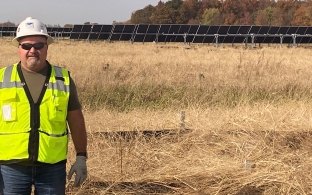What is Utility-Scale Solar?
The current state of solar power is exciting, but solar is just getting started.


Utility-scale solar power plants generate and distribute power to nearby homes and businesses at the grid scale. Solar energy at this scale can augment or replace power plants that rely on non-renewable fossil fuels like coal or natural gas. Solar has become the most likely candidate to lead renewable energy generation in the United States and globally.
The current state of solar power is exciting, but solar is just getting started.
Grid-scale Solar Snapshot
What is a utility-scale solar project? The precise definition varies slightly.
The Solar Energy Industries Association (SEIA) considers any solar project capable of generating 1 megawatt (MW) to be grid-scale. For context, that’s enough energy to power roughly 400-900 homes annually.
The National Renewable Energy Laboratory requires 5 MW to be considered utility-scale. The definition varies by market, ranging from 2 MW to 25 MW.
Varied thresholds aside, solar power has more growth potential than other renewables, such as wind or hydropower.
Related: Solar Site Evaluation and Preparation
Solar Energy Growth – An Industry on the Rise
In 2007, the US had just 470 utility-scale solar installations generating less than 100 MW. A decade later, the US had 1,811 installations contributing to a total US solar capacity of more than 50,000 MW, a 285.3% increase in grid-scale facilities.
Technology improvements in photovoltaic materials, or PV cells, have improved approximately 10-15% in the past five years, increasing the potential of every solar farm across the country. Today, 1,701 utility-scale solar plants generate more than 58% of the roughly 130,000 MW of solar energy produced in the US, with the remaining 42% produced by small-scale installations.
The Cost of Going Solar
Solar energy’s contribution to new energy production has increased exponentially over the past decade. In 2022, 60% of all new renewable energy capacity was from solar development, with a further 200 gigawatt (GW) increase expected by the end of 2023.
The growth of solar is directly tied to the dramatic decrease in installation costs. Despite marginal year-over-year decreases for both residential (5%) and commercial and utility-scale (15-18%) in 2021, total prices for installed capacity have fallen from nearly $6 in 2010 to $1.48 in 2021. The 2021 short-term price increase was mainly attributable to the rise in demand and considerable supply chain challenges that have plagued multiple industries since 2020. The Inflation Reduction Act addresses short- and long-term barriers to solar development, including substantial rebates and incentives.
Solar panels lined up in a field.
Utility-Scale Solar FAQs
As the civil construction partner on more than 30 utility-scale solar facilities, we’ve had a first-hand look at every element of bringing grid-scale solar projects to life. The rapid growth of the industry and its technological advancement often creates questions for even industry-leading developers and municipalities. Our Renewable team answered several of the most common questions we receive on solar projects; get in touch to learn more.
Which US state generates the most utility-scale solar power?
California leads the US in the number of solar installations and total capacity. In 2022, California’s total solar power capacity was 37 gigawatts. Texas generated the second-most solar energy at approximately 15 gigawatts.
What types of solar cells are used on utility-scale panels?
Most utility-scale projects rely on thin-film solar panels. These are produced by adding a thin layer of photovoltaic material over a firm non-porous surface. Thin-film solar panels are the least efficient type of panel as well as the least expensive. They tend to be more resilient to the elements and their lower costs make sizeable developments financially feasible.
What batteries do utility-scale solar plants use?
Lithium-ion battery storage capacity has increased nearly as rapidly as PV efficiency. Unfortunately, raw material prices for lithium, nickel and other essential components of lithium-ion batteries have increased since 2020 due to rising demand for electric vehicles, processing chips, and other electronics. Supply chain constraints and material availability have also played a role, with Russia’s invasion of Ukraine putting roughly 20% of the world’s nickel supply at risk. Ukraine is also the second and fourth-largest supplier of cobalt and graphite, respectively, which are two more materials used to manufacture lithium-ion batteries.
How is utility-scale solar different than residential solar panels?
Utility-scale solar is generated at a central site and distributed to homes and businesses in the area. Residential solar power is generated on-site and used on-site. Some residential and commercial solar installations include a connection to the grid that allows for two-directional flow. This allows the privately owned solar panel installation to contribute to total grid capacity, but usually in negligible amounts. Grid-scale facilities generate roughly 60% of total solar capacity.
Building the Future of Solar from the Ground Up
Castle has been at the forefront of utility-scale solar development. Our team brings experience and expertise in sitework, grading, utility trenching and more. Start your grid-scale solar project or battery storage facility with a strong foundation. Contact Castle Contracting today to learn more.







